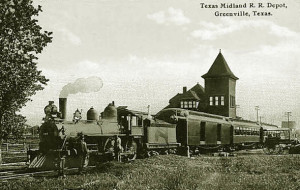Probably one of the wealthiest men associated with Greenville at the beginning of the twentieth century was a tall, robust New Yorker named Edward Howland Robinson Green (1868-1936). Born in London to very wealthy parents, Green was educated in New York and studied law in Chicago. At age 24, his mother Hetty Green, frequently referred to as “The Witch of Wall Street” bought her son the Houston and Texas Central railroad, then sent him to Texas to run it. E. H. R. Green became president and general manager of the newly formed Texas Midland Railroad in 1892. The initial capitalization of the company was $500,000.
While Green presided over his railroad and numerous business, social, and political activities from his headquarters in Terrell, his influence reached into Hunt County. His business plan was fairly simple, to link short line railroads to transcontinental routes. He planned to build a franchise to the Red River, eventually covering only 100 miles of track. Green also intended to acquire better and more luxurious equipment along with the expansion of rail lines.
In 1895 track connected Roberts to Greenville was completed through the new town of Quinlan. Two years later track reached Paris through Commerce. Heavy rails were used on all new tracks. Green paid cash for rights-of-ways and asked for no donations as earlier rail lines had done. At first the Midland used the Cotton Belt tracks from Greenville to Commerce until 1921 when the Midland built its own tracks.
Green and his railroad owned only six locomotives and 196 cars in 1895. By 1926 he owned 16 locomotives and 233 cars. At that time, annual passenger revenues amounted to over $67,000 with revenues from freight at more that $704,000.
Instead of obtaining long routes, the Midland became the first to use electric lights on engines and in coaches in Texas. Green experimented with air-conditioning in passenger cars. He was one of the early railroad executives to use steel boxcars and high-speed gas and electric railcars. These motorcars were powered with dynamos driven by high-speed gasoline engines. Each car was 70 feet long, all steel with a seating capacity of 100 persons. The cost for every car was $26,000. Amazingly the cars were only used in passenger travel from Paris to Dallas through Greenville. On the last leg of the trip, riders travelled along the Texas and Pacific tracks to Dallas.
A century ago E. R. H. Green drilled the first oil well in Hunt County. Naturally it caused a tremendous amount of curiosity and excitement, even if the well was not a big producer. Green sponsored rail excursions to Texas for Northern farmers to inspect and purchase farms. A large contingency arrived in Greenville before the onset of World War I. He brought the first automobile to Texas and supported experimental farms in Kaufman County.
E. H. R. Green sold his railroad to Southern Pacific in 1928, even though Greenville newspapers reported rumors of the intended sale as early as 1915.
He and his wife moved to New York where he controlled his mother’s business empire. When Green died in 1938 his estate was valued at 40 million dollars. An interesting anecdote revealed that Green had an artificial leg. As was the custom of the day, his amputated leg was buried at a cemetery. At his death his widow had it exhumed and buried with his body.


Come to the Ennis railroad museum and asked for me and I will come give you a personal tour and tell you things about the Midland that was told to me by the men that worked it and about the Greens that is not in any books.
I’m planning a “Texas Midland Scrapbook” as my presentation subject at the 14th Cotton Belt Symposium on October 5, 2019 at Texas A&M Commerce.